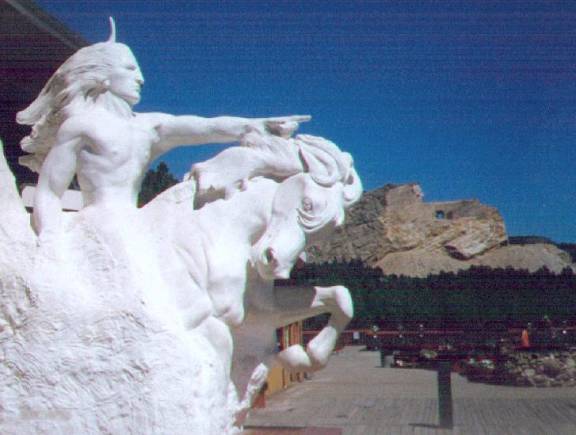LITR 4332: American Minority
Literature

Student Poetry Presentation 2004
Reader: Karen Daniel
Respondent: Jennifer Condado
"Crazy Horse Monument"
by
Peter Blue Cloud (Aroniawenrate)
a. k. a. Peter Williams
Unsettling
America, 179-180


Biography:
Peter Blue Cloud / Aroniawenrate was born in 1935 to the Turtle Clan of the
Mohawk tribe on the Caughnawaga Reserve in Kahnawake, Quebec, Canada.
He has worked as ironworker, logger, carpenter and woodcutter and was
previously associated with journal Akwesasne Notes and the journal Indian
Magazine. In the late 1960s, he
began publishing his poems. With
these, he emphasized and introduced the traditional ways of thinking into
contemporary American literature, describing man in nature and history, man and
nature as one, as it was always perceived by the aboriginal people.
In 1981, he has received the American Book Award, Before Columbus
Foundation. His books of fiction,
non-fiction and poetry include "Alcatraz is not an island", 1972;
"Back then tomorrow", 1978; "White corn sister", 1979;
"Sketches in winter, with crows", 1984; "Elderberry flute song :
contemporary coyote tales", 1989; " The other side of nowhere :
contemporary coyote tales", 1990; "Clans of many nations : selected
poems, 1969-1994", 1995. Peter
Blue Cloud is an honorary member of the Edge-ucation Council.
Blue Cloud is noted for combining
Native American myths with contemporary issues.
He is especially noted for his use of the Coyote figure in his stories
and poems.
Great Links:
The Internet
Public Library; Native American Authors
Great Quote:
“Cloud's poems are living proof that the power and
beauty of the old way cannot be lost. Blue
Cloud does nothing glamorous. He
lives in the present, totally. He
invents nothing —he speaks from his own heart and life.
He is a true poet, at home in all times, everywhere.
His language is his tool. His
words echo the contradictions, complexities, suffering, and oddly optimistic
future visions that mark the Twentieth-Century, Julian calendar.”
—Gary Snyder
Course Objectives:
1. Objective 1a—Involuntary Participation—The American Nightmare
2. Objective 3b—Loss and Survival
3.
Objective 5a—To discover the power of poetry and fiction to help
"others" hear the minority voice and vicariously share the
minority experience.
Literary Term:
Metaphor: The Bedford
Glossary of Literary Terms; second Edition, defines metaphor as a figure of
speech (more specifically a trope) that associates two distinct things; the
representation of one thing by another.
Imagery: A term used
to refer to the actual language that a writer uses to convey a visual picture.
Blue Cloud uses a lot of both of these literary devices in
this poem. The poem comes alive for
the reader because of his vivid techniques.
Interpretation:
In this poem, Blue Cloud is “remembering” the trail of tears, a
movement by the United States government that displaced thousands of American
Indians in 1876. The Indian leader
of this movement was Crazy Horse, and poem centers on him, his devotion to his
people, and his anger and despair over their fate.
In 2000, Sonya Deal stated that: This poem is its own monument to Crazy Horse. While I agree with her, I think it goes further than that. Blue Cloud seems to feel that Crazy Horse would be less than thrilled with the monument that has been erected for him, and perhaps feels that remembering their pain and plight would be a better memorial to the great chief. He questions what use Crazy Horse would have for destroying the side of a mountain with dynamite to erect a statue like the Greeks and Romans carved when what his people really need is so much more practical than that.
Questions:
1.
What do you think the author meant by the refrain?
Especially “his people’s sleep” and “a future storm.”
2.
What do you think about the monument to Crazy Horse.
What do you think the Indians feel about it?
3.
How does the author make you feel about the Trail of Tears with his vivid
images of the plight of the American Indians?